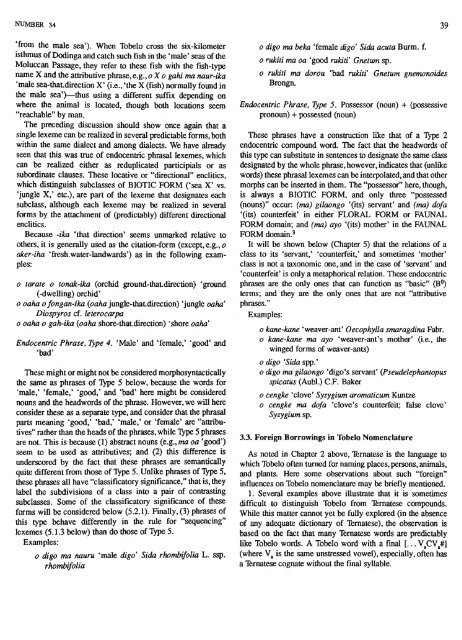The Folk Biology of the Tobelo People - Smithsonian Institution ...
The Folk Biology of the Tobelo People - Smithsonian Institution ...
The Folk Biology of the Tobelo People - Smithsonian Institution ...
Create successful ePaper yourself
Turn your PDF publications into a flip-book with our unique Google optimized e-Paper software.
NUMBER 34 39<br />
'from die male sea'). When <strong>Tobelo</strong> cross <strong>the</strong> six-ktiometer<br />
isthmus <strong>of</strong> Dodinga and catch such fish in die 'male' seas <strong>of</strong> die<br />
Moluccan Passage, <strong>the</strong>y refer to <strong>the</strong>se fish with <strong>the</strong> fish-type<br />
name X and die attributive phrase,e.g.,0X0 gahi ma naur-ika<br />
'male sea-thatdirection X' (i.e., 'die X (fish) normaUy found in<br />
<strong>the</strong> male sea')—thus using a different suffix depending on<br />
where die animal is located, though both locations seem<br />
"reachable" by man.<br />
<strong>The</strong> preceding discussion should show once again that a<br />
single lexeme can be realized in several predictable forms, botii<br />
within <strong>the</strong> same dialect and among dialects. We have already<br />
seen tiiat this was true <strong>of</strong> endocentric phrasal lexemes, which<br />
can be realized eitiier as reduplicated participials or as<br />
subordinate clauses. <strong>The</strong>se locative or "directional" enclitics,<br />
which distinguish subclasses <strong>of</strong> BIOTIC FORM ('sea X' vs.<br />
'jungle X,' etc.), are part <strong>of</strong> <strong>the</strong> lexeme that designates each<br />
subclass, altiiough each lexeme may be realized in several<br />
forms by <strong>the</strong> attachment <strong>of</strong> (predictably) different directional<br />
enclitics.<br />
Because -ika 'that direction' seems unmarked relative to<br />
otiiers, it is generally used as die citation-form (except, e.g., o<br />
aker-iha 'fresh.water-landwards') as in die foUowing examples:<br />
o tarate o tonak-ika (orchid ground-thatdirection) 'ground<br />
(-dweUing) orchid'<br />
o oaha <strong>of</strong>ongan-ika (oaha jungle-thatdirection) 'jungle oaha'<br />
Diospyros cf. leterocarpa<br />
o oaha o gah-ika (oaha shore-that.direction) 'shore oaha'<br />
Endocentric Phrase, Type 4. 'Male' and 'female,' 'good' and<br />
'bad'<br />
<strong>The</strong>se might or might not be considered morphosyntacticaUy<br />
die same as phrases <strong>of</strong> Type 5 below, because <strong>the</strong> words for<br />
'male,' 'female,' 'good,' and 'bad' here might be considered<br />
nouns and die headwords <strong>of</strong> die phrase. However, we wUl here<br />
consider tiiese as a separate type, and consider tiiat <strong>the</strong> phrasal<br />
parts meaning 'good,' 'bad,' 'male,' or 'female' are "attributives"<br />
ra<strong>the</strong>r than <strong>the</strong> heads <strong>of</strong> die phrases, while Type 5 phrases<br />
are not. This is because (1) abstract nouns (e.g., ma oa 'good')<br />
seem to be used as attributives; and (2) tiiis difference is<br />
underscored by die fact tiiat <strong>the</strong>se phrases are semanticaUy<br />
quite different from those <strong>of</strong> Type 5. Unlike phrases <strong>of</strong> Type 5,<br />
tiiese phrases all have "classificatory significance," tiiat is, <strong>the</strong>y<br />
label <strong>the</strong> subdivisions <strong>of</strong> a class into a pair <strong>of</strong> contrasting<br />
subclasses. Some <strong>of</strong> <strong>the</strong> classificatory significance <strong>of</strong> <strong>the</strong>se<br />
forms wiU be considered below (5.2.1). FinaUy, (3) phrases <strong>of</strong><br />
this type behave differendy in <strong>the</strong> rule for "sequencing"<br />
lexemes (5.1.3 below) tiian do tiiose <strong>of</strong> Type 5.<br />
Examples:<br />
o digo ma nauru 'male digo' Sida rhombifolia L. ssp.<br />
rhombifolia<br />
o digo ma beka 'female digo' Sida acuta Burm. f.<br />
o rukiti ma oa 'good ruldti' Gnetum sp.<br />
o rukiti ma dorou 'bad rukiti' Gnetum gnemonoides<br />
Brongn.<br />
Endocentric Phrase, Type 5. Possessor (noun) + (possessive<br />
pronoun) + possessed (noun)<br />
<strong>The</strong>se phrases have a construction like tiiat <strong>of</strong> a Type 2<br />
endocentric compound word. <strong>The</strong> fact that <strong>the</strong> headwords <strong>of</strong><br />
tiiis type can substitute in sentences to designate die same class<br />
designated by die whole phrase, however, indicates tiiat (unlike<br />
words) tiiese phrasal lexemes can be interpolated, and tiiat odier<br />
morphs can be inserted in diem. <strong>The</strong> "possessor" here, though,<br />
is always a BIOTIC FORM, and only tiiree "possessed<br />
(nouns)" occur: (ma) gilaongo '(its) servant' and (ma) d<strong>of</strong>a<br />
'(its) counterfeit' in ei<strong>the</strong>r FLORAL FORM or FAUNAL<br />
FORM domain; and (ma) ayo '(its) motiier' in <strong>the</strong> FAUNAL<br />
FORM domain. 3<br />
It wtil be shown below (Chapter 5) tiiat die relations <strong>of</strong> a<br />
class to its 'servant,' 'counterfeit' and sometimes 'motiier'<br />
class is not a taxonomic one, and in die case <strong>of</strong> 'servant' and<br />
'counterfeit' is only a metaphorical relation. <strong>The</strong>se endocentric<br />
phrases are die only ones tiiat can function as "basic" (B°)<br />
terms; and tiiey are <strong>the</strong> only ones that are not "attributive<br />
phrases."<br />
Examples:<br />
o kane-kane 'weaver-ant' Oecophylla smaragdina Fabr.<br />
o kane-kane ma ayo 'weaver-ant's mo<strong>the</strong>r' (i.e., <strong>the</strong><br />
winged forms <strong>of</strong> weaver-ants)<br />
o digo 'Sida spp.'<br />
o digo ma gilaongo 'digo's servant' (Pseudelephantopus<br />
spicatus (Aubl.) CF. Baker<br />
o cengke 'clove' Syzygium aromaticum Kuntze<br />
o cengke ma d<strong>of</strong>a 'clove's counterfeit; false clove'<br />
Syzygium sp.<br />
3.3. Foreign Borrowings in <strong>Tobelo</strong> Nomenclature<br />
As noted in Chapter 2 above, Ternatese is die language to<br />
which <strong>Tobelo</strong> <strong>of</strong>ten turned for naming places, persons, animals,<br />
and plants. Here some observations about such "foreign"<br />
influences on <strong>Tobelo</strong> nomenclature may be briefly mentioned.<br />
1. Several examples above iUustrate that it is sometimes<br />
difficult to distinguish <strong>Tobelo</strong> from Ternatese compounds.<br />
Whde tiiis matter cannot yet be fuUy explored (in die absence<br />
<strong>of</strong> any adequate dictionary <strong>of</strong> Ternatese), die observation is<br />
based on die fact tiiat many Ternatese words are predictably<br />
like <strong>Tobelo</strong> words. A <strong>Tobelo</strong> word with a final [... VaCVa#]<br />
(where Va is <strong>the</strong> same unstressed vowel), especially, <strong>of</strong>ten has<br />
a Ternatese cognate witfiout <strong>the</strong> final syllable.

















